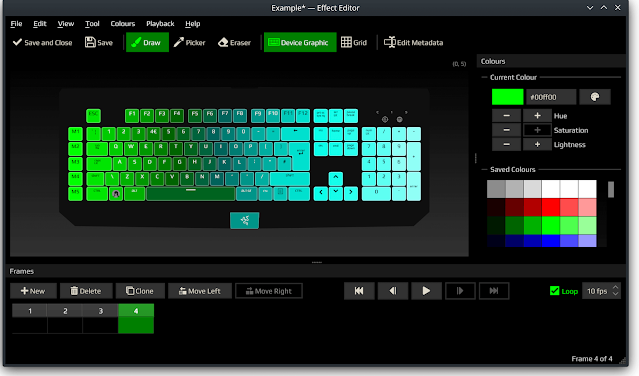Razer Peripherals Config App For Linux Polychromatic Sees First Major Stable Release In Three Years
Polychromatic, an open source GUI tool to configure RGB (Razer only for now) peripherals on Linux, has seen its first new stable release in 3 years. The latest 0.7.0 version comes with an overhauled user interface which includes an effects editor, and improved support for newer OpenRazer hardware.
Polychromatic can be used to tweak Razer (*) peripherals on Linux, from setting the DPI and poll rate, to controlling lighting effects, and more. This is done using OpenRazer as its backend, which supports peripherals like the Razer BlackWidow (Chroma, Elite, Chroma v2, Essential, Lite, Stealth, etc.) keyboards, Razer DeathAdder (3500, Chroma, Elite, Essential), Mamba or Naga mice, headphones, laptop keyboards, and more. See here a list of compatible devices.
Up until this release, Polychromatic only supported OpenRazer devices, with this being a "hard" dependency. That's no longer the case though, and while Polychromatic still supports OpenRazer, you can now run this tool without OpenRazer installed, but with limited functionality.
The goal is to make Polychromatic vendor-agnostic, and not just for Razer devices. To do this, the plan is to add support for new backends like OpenRGB (which supports many peripheral brands, including those manufacturing GPU, MB and RAM modules), phue (for Philips Hue support), and possibly others.
Polychromatic 0.7.0 comes with an overhauled user interface, with the main application now being based on PyQt5 instead of WebKitGTK. The developers mention that the look and feel may seem similar, but this is no longer a hybrid web app and instead, it's a traditional desktop application.
With this overhaul, there are many new and updated elements, including a new tab and sidebar interface, new preferences dialog, etc.
There's also a new Effect Editor that can be used to create your own static and animated light effects for any device with individually addressable LEDs (image via the Polychromatic release notes):
For a few select devices, Polychromatic comes with build-in device graphics for the Effects Editor, like Razer BlackWidow Chroma and Elite, Razer Mamba Elite and Tournament Edition, Razer Blade Stealth, Blade and Brade Pro, and a few others.You might also like: OpenRGB: Open Source RGB Lighting Control For Keyboards, Fans, Mice And Much More
The device support has also been improved with this release. Polychromatic 0.7.0 adds support for multizoned hardware (including the logo, scroll wheel, and battery charging states), as well as support for battery status, sleep and low power modes.
Polychromatic 0.7.0 comes with many other changes, like an updated tray (which you can now set to use GTK Status Icon (legacy)), new option to start the application on system startup with a delay, and much more. See the full release notes for a complete list.
It's worth noting that Polychromatic daily builds / latest git builds have been available for some time for various Linux distributions, like a PPA for Ubuntu / Linux Mint, and an AUR package for Arch Linux / Manjaro. So if you were using those packages, this updated interface is not something new to you, but this is, nevertheless, an important new stable release.
Want to remap your keyboard keys or mouse buttons? You can't use Polychromatic for that yet. Instead, see:
- Remap Keyboard And Mouse Buttons On Linux With The New Key Mapper GUI (Supports X11 And Wayland)
- How To Bind Mouse Buttons To Keyboard Keys Or Commands (Linux Using X11)
Download Polychromatic
It's important to note that to use this you'll need not only Polychromatic, but also its OpenRazer backend. You may need to reboot the system after installing OpenRazer and adding your username to the plugdev group (sudo gpasswd -a $USER plugdev).
For other devices, you might like: Configure Logitech, Steelseries And Other Gaming Mice On Linux Using Piper










